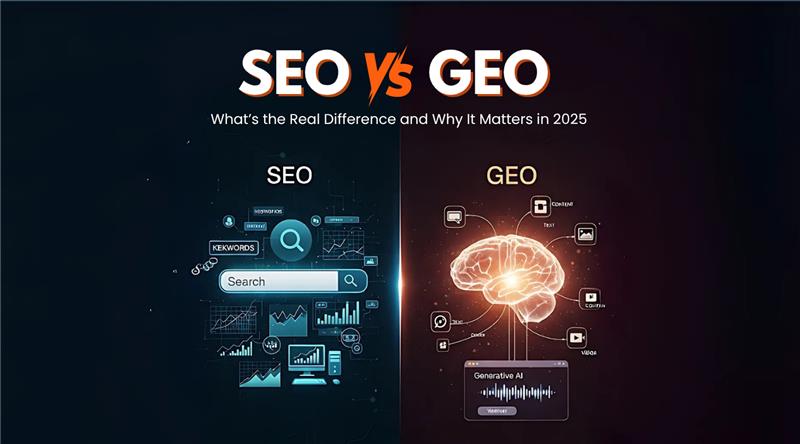Introduction
Digital marketing professionals often confuse two fundamental concepts that drive online visibility: Search Engine Optimization (SEO) and Generative Engine Optimization (GEO). While both strategies aim to increase online presence, they operate through distinctly different mechanisms and target separate user behaviors. Understanding these differences has become crucial as artificial intelligence reshapes how consumers discover information online.
Recent studies indicate that 85% of marketers struggle to differentiate between traditional SEO tactics and emerging GEO strategies. This confusion costs businesses millions in misdirected marketing efforts and lost opportunities. Moreover, with AI-powered search experiences gaining prominence, companies that fail to adapt their optimization strategies risk becoming invisible to their target audiences.
This comprehensive guide will clarify the fundamental differences between SEO and GEO, helping you make informed decisions about your digital marketing investments. You’ll discover actionable strategies that leverage both approaches to maximize your online visibility and drive sustainable business growth.
Understanding SEO: The Foundation of Digital Visibility
Search Engine Optimization represents the traditional approach to improving website visibility in search engine results pages (SERPs). This methodology focuses on optimizing content, technical elements, and off-page factors to rank higher for specific keywords and phrases.
SEO operates through several core components. First, on-page optimization involves crafting content that satisfies user intent while incorporating relevant keywords naturally. Technical SEO ensures websites load quickly, display properly across devices, and provide excellent user experiences. Additionally, off-page SEO builds authority through high-quality backlinks and social signals.
The traditional SEO ecosystem relies heavily on Google’s ranking algorithms, which evaluate hundreds of factors to determine search result positions. Content quality, relevance, authority, and user experience signals all contribute to a website’s ranking potential. Furthermore, SEO professionals continuously adapt their strategies as search engines update their algorithms to deliver better user experiences.
Successful SEO campaigns typically generate results over 3-6 months, requiring consistent effort and patience. However, the long-term benefits include sustained organic traffic, improved brand credibility, and cost-effective customer acquisition compared to paid advertising channels.
Introducing GEO: The Next Evolution in Search Optimization
Generative Engine Optimization represents a revolutionary approach to content optimization specifically designed for AI-powered search experiences. Unlike traditional SEO, GEO focuses on optimizing content for generative AI systems that provide direct answers rather than lists of links.
GEO strategies center on creating content that AI systems can easily understand, synthesize, and present as authoritative responses. This involves structuring information in ways that facilitate AI comprehension while maintaining human readability and engagement. Additionally, GEO emphasizes factual accuracy, source credibility, and comprehensive coverage of topics.
The fundamental difference lies in user interaction patterns. Traditional search engines direct users to websites through blue links, while generative engines provide immediate answers within their interfaces. Consequently, GEO-optimized content must deliver value even when users never visit the original source website.
Early adopters of GEO strategies report significant improvements in brand visibility within AI chat interfaces and voice assistants. However, measuring GEO effectiveness requires new metrics beyond traditional click-through rates and rankings, focusing instead on citation frequency and answer prominence.
Key Differences Between SEO and GEO
Target Platforms and Algorithms
SEO primarily targets traditional search engines like Google, Bing, and Yahoo, optimizing for their specific ranking algorithms. These platforms evaluate websites based on relevance, authority, and user experience signals to determine search result positions.
Conversely, GEO targets generative AI platforms such as ChatGPT, Claude, Perplexity, and emerging AI search features. These systems use large language models to generate responses rather than simply ranking existing content. Therefore, optimization strategies must focus on content structure and factual accuracy rather than traditional ranking factors.
Content Optimization Approaches
Traditional SEO emphasizes keyword optimization, meta descriptions, title tags, and internal linking structures. Content creators focus on incorporating target keywords naturally while maintaining readability and user engagement. Additionally, SEO content often targets specific search queries with dedicated landing pages.
GEO optimization prioritizes comprehensive topic coverage, factual accuracy, and clear information hierarchy. Content must be structured to help AI systems understand context, relationships between concepts, and authoritative sources. Furthermore, GEO content often adopts a more encyclopedic approach, covering topics thoroughly rather than targeting narrow keyword phrases.
Measurement and Analytics
SEO success metrics include organic traffic, keyword rankings, click-through rates, and conversion rates. These quantifiable metrics allow marketers to track progress and demonstrate return on investment. Moreover, established tools like Google Analytics and Search Console provide detailed performance insights.
GEO measurement remains in its infancy, with limited tools available for tracking citation frequency and answer prominence. Marketers must develop new methodologies for measuring brand visibility in AI-generated responses. Nevertheless, early indicators suggest that GEO effectiveness correlates with brand mention frequency and context quality in AI outputs.
Timeline and Implementation
SEO campaigns typically require 3-6 months to show significant results, with ongoing optimization needed to maintain rankings. The competitive nature of traditional search results means that businesses must continuously invest in content creation and technical improvements.
GEO implementation can potentially show faster results, as AI systems quickly index and utilize new authoritative content. However, the nascent nature of GEO means that best practices continue evolving rapidly. Therefore, businesses must remain agile and adapt their strategies as AI platforms develop new capabilities.
Frequently Asked Questions About SEO vs GEO
Can businesses use both SEO and GEO strategies simultaneously?
Absolutely. Smart marketers integrate both approaches to maximize their digital presence across traditional and AI-powered search experiences. While some tactics overlap, each strategy serves different user behaviors and search contexts. Companies that master both methodologies gain competitive advantages as search landscapes evolve.
Which approach delivers better ROI for small businesses?
The answer depends on your target audience and business objectives. SEO typically provides more measurable short-term results through increased website traffic and conversions. However, GEO may offer long-term advantages as AI-powered search becomes more prevalent. Most experts recommend starting with solid SEO foundations while gradually incorporating GEO elements.
How do I know if my content is optimized for generative engines?
Test your content by asking AI chatbots specific questions related to your topic. If your information appears in their responses with proper attribution, your GEO optimization is working. Additionally, monitor brand mentions in AI-generated content and track how accurately systems represent your expertise.
Will traditional SEO become obsolete as AI search grows?
Traditional SEO will evolve rather than disappear entirely. While AI-powered search changes user behaviors, many consumers still prefer browsing websites directly. Therefore, businesses need hybrid strategies that address both traditional and generative search experiences. The most successful companies will adapt their optimization approaches while maintaining strong SEO foundations.
Strategic Implementation: Combining SEO and GEO
Successful digital marketing strategies now require integrating both SEO and GEO approaches to capture the full spectrum of search behaviors. Start by auditing your current content to identify opportunities for enhancement across both methodologies.
Develop content that serves dual purposes: ranking well in traditional search engines while providing clear, authoritative information that AI systems can easily process and cite. This involves creating comprehensive topic clusters that demonstrate expertise while maintaining keyword optimization for human searchers.
Invest in tools and training that support both SEO and GEO measurement. While GEO analytics remain limited, establishing baseline metrics now positions your business for future success as measurement capabilities improve. Additionally, stay informed about emerging AI platforms and their content preferences.
Conclusion
The digital marketing landscape continues evolving as artificial intelligence transforms how consumers discover and consume information. Understanding the critical differences between SEO and GEO empowers marketers to develop comprehensive strategies that maximize visibility across all search experiences.
While traditional SEO remains essential for driving website traffic and conversions, GEO represents the future of content optimization in an AI-driven world. Businesses that recognize these differences and adapt their strategies accordingly will gain significant competitive advantages as search behaviors continue changing.
Success in today’s digital environment requires embracing both methodologies while staying agile enough to adapt as new platforms and technologies emerge. By implementing the strategies outlined in this guide, you’ll position your business for sustained growth regardless of how search landscapes evolve.





